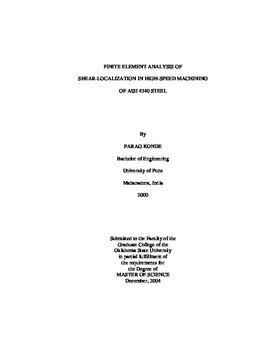| dc.description.abstract | Hardened AISI 4340 steel is one of the difficult-to-machine materials. As the cutting speed increases, the chip morphology changes from discontinuous chip, to continuous chip, to shear-localized chip. At speeds above this, the shear-localized chips continue to form except that instead of continuous series of segments in the chips, the segments get isolated. As the hardness of the workmaterial increases, these transitions occur at much lower speeds. To understand the mechanism of chip formation in high-speed machining of AISI 4340 steel, finite element analysis is used. It is a Lagrangian explicit finite element code available commercially (AdvantEdgeTM). To overcome the problems associated with extensive element distortion, adaptive meshing and remeshing are used. Johnson-Cook's material model that is capable of giving flow stresses at various strains, strain rates, and temperature is used along with Recht's catastrophic shear failure criterion. A user-subroutine (UMAT) is developed to incorporate Johnson-Cook's material model and Recht's catastrophic shear failure criterion in the finite element code. Effects of workmaterial hardness, cutting speed, tool rake angle, and contact length on the chip morphology, temperature, strains, forces, and power are investigated. Finite element analysis of the machining of AISI 4340 steel is studied for different hardness values, viz., 215 BHN, 325 BHN, and 520 BHN. The cutting speed used are 65 m/min and 488 m/min to machine AISI 4340 steel (215 BHN), 40 m/min, 125 m/min, and 275 m/min to machine AISI 4340 steel (325 BHN), 15 m/min and 61 m/min to machine AISI 4340 steel (520 BHN). The tool rake angles used for all the simulations are -15�, -5�, 15�, and 30� and the depth of cut used is 0.5 mm. The model is validated by comparing the simulation results with the experimental results published in the literature and also with the results from another finite element code, ABAQUS for which conventional method of Johnson-Cook's constitutive and damage model was used. The results of the present investigation agree reasonably with the experimental results published in the literature (difference less than 11%). Also, the shear-localization process agrees closely with the process published in the literature. | |
